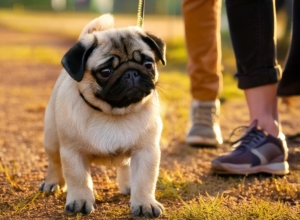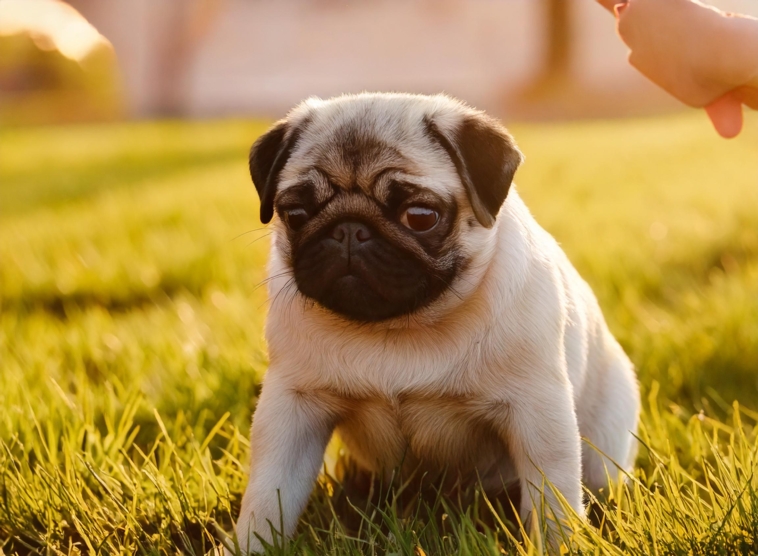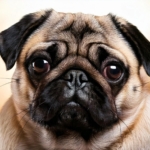House Training: AKA Not Peeing on the Rug
Housebreaking a pug is half science, half strategy, and 100% patience. Be prepared to spend a lot of time outdoors—and standing around like a demented cheerleader waiting for nature to occur.
- Choose the Poop Spot: One place only. Dogs thrive on routine, and your rug will appreciate it.
- Follow a Schedule: Morning, after meals, and before bedtime = potty party time.
- Reward Success: Pee outdoors? Treat time! Pee indoors? Sigh heavily, but don’t punish.
- Watch Like a Hawk: Keep your eye on the pug inside at all times—like the sneaky toddler they are, they will discover that one place you didn’t happen to mop.
- Crate = Life Saver: Their tiny puppy condo protects them and limits indoor “whoopsies.”
Teaching Basic Commands: Sit, Stay, and Don’t Lick That
Pugs are as difficult to train as potatoes are to dance—plenty of time, treats, and repetition.
- Sit: Coax that soft bottom onto the ground with a treat held high over the head. Say “Sit.” Snuggle. Do it again.
- Come: Leash ’em up, tug ’em gently, and say “Come!” like you’re saying pizza. Reward when they arrive. Fake it ’til you make it.
Pro tip: Pugs learn most effectively when training is less formal and ends with rewards. Sort of like toddlers. Or me, for that matter.
How to Turn a Pug Puppy Into a Social Butterfly
If you want your pug to be cool, confident, and not scream at trash cans, early socialization is the way to go.
- Start Young: 3–14 weeks is the sweet spot for introductions to the world.
- Mix It Up: Parks, sidewalks, Grandma’s kitchen—each new location does the trick.
- Reward Calmness: If they don’t shriek at a bike or slurp a stranger, they get a cookie.
Crate Training 101: Not a Doggy Jail
Done right, a crate is your pug’s haven, not puppy prison. Here’s how to make it comfortable, not creepy.
Do:
- Layer it with blankets, toys, and your old T-shirt (they love your smell).
- Add treats to make it a snack cave of joy.
Don’t:
- Leave them in there forever. You don’t want to sleep in a closet for 8 hours either.
- Stuff them in like a reverse magic trick. Let it be their choice.
- Don’t mind the whining—they’re not melodramaticing each time (okay, perhaps 80%).

Common Pug Puppy Shenanigans & What To Do
- Chewing: Monitor hawk-like. Redirect to toys unless you like tooth-marked remotes.
- Barking: Determine what they’re barking at. Reward silence as an Olympic sport.
- Pouting: They do this. Be firm. Bribe them out of their drama.
- Separation Anxiety: Puzzle toys = diversion. Leave for 5 minutes, then gradually more.
- Nipping: Substitute with toys instead of your toes. Train “gentle” like a yogi.
Positive Reinforcement: Jedi Mind Tricks for Pugs
Make your pug obey. Go light on the tasty treats.
- Treats: Skinner trained pigeons on snacks. You can definitely train a pug the same.
- Verbal Praise: Pleased “Good job!” + food = lifetime compliance (or at least until the treat runs out).
- Clicker Training: Click + treat = magic. It makes them know exactly what they did right without reading your mind
Exercise & Play: The Zoomies Must Flow
They may look like marshmallow-walking dogs, but pug puppies have a lot of energy. Get ’em active or prepare for midnight zoomies.
- Walks: 20–30 minutes daily. Leisured, with regular sniffing breaks.
- Interactive Play: Tug toys, squeaky balls, puzzle feeders—anything to stimulate that small brain.
- Mini Training Games: Train cues during play to double the fun.
- Doggy Playdates: Socialize them. Pugs are social butterflies. They need their crew.
Grooming: Beauty Comes with Wrinkles
Low-shedding, yet diva high-maintenance. Here’s the key to keeping them cute and clean:
- Wrinkle Wipe-Down: Daily wipe-downs. Folds tend to catch everything.
- Nail Clipping: Twice a month trims unless you like pug claws.
- Ear Cleaning: Weekly ear spa to prevent infection and ear odor.
Training Recap: Patience, Consistency, and Snacks
Pug puppy raising is a marathon, not a sprint. Some advice from the pug parent playbook:
- Patience: It happens gradually, like dial-up internet. But it works.
- Consistency: Eat, walk, and train by the clock. Dogs like to know what’s next.
- Positive Vibes Only: Ditch the yelling—your pug will only get insulted and tune you out harder.
Remember, pugs are small comedians in a dog suit. With the right balance of snacks, praise, and naps, you’ll go from chaos goblin to charming companion in no time.




